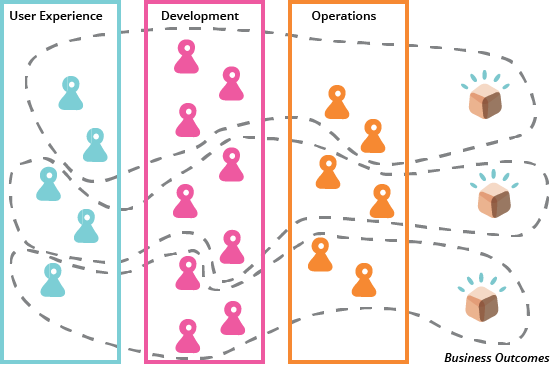ActivityOriented
Any significant software development effort requires several different activities to occur: analysis, user experience design, development, testing, etc. Activity-oriented teams organize around these activities, so that you have dedicated teams for user-experience design, development, testing etc. Activity-orientation promises many benefits, but software development is usually better done with OutcomeOriented teams.

Traditionally, big businesses with large IT departments (Enterprise IT) have tended to execute IT development projects with a bunch of activity-oriented teams drawn from a matrix IT organization (functional organization). The solid-lined arms of the matrix (headed by a VP of development, testing and so on) are usually along activity boundaries and they loan out “resources” to dotted-lined project or program organizations. Common justifications for doing so include:
- It helps standardization of conventions and techniques in development if all developers report into a single organization (arm of the matrix). Same for testing etc.
- It helps the cause of mentoring, training and nurturing the competency in general if all developers have long-lived development/engineering managers. Same for testing etc.
- It helps maximize utilization of talent (and thereby improve cost-efficiency) by staffing projects from pools of supposedly fungible developers, testers etc.
However, activity-oriented teams are prone to optimize for their own activity and not for the bigger picture of delivering useful software. This is a consequence of what they are held responsible for and how they are measured. It is common for a team of only developers to only be measured by their velocity. If they are only tasked with delivering scope, they will not think about whether it is going to solve the problems it was meant to. Even if they do so, they may be discouraged by the product management team - another activity-oriented team that is only responsible determining the spec.
Organizing by activity gets in the way of lowering batch size of work that is handed-off between teams. A separate team of testers won’t accept one story at a time from a team of developers. They’d rather test a release worth of stories or at least all stories in a feature at a time. This lengthens the feedback loop, increases end-to-end cycle time and hurts overall responsiveness.
High speed IT calls for motivated teams. Autonomy is a key motivator for teams. However, activity oriented organization can only be granted so much autonomy because they tend to use it for optimizing their sphere of activity.
A variation of activity-oriented organization are super-specialized teams that may result in the following ways:
- Tool or skill centric teams: e.g. a WebSphere Portal Server team or a BizTalk team
- Architectural Layer teams: e.g. a presentation layer team, middleware team, data layer team.
They are problematic because they have a narrow focus and they tend to optimize for team performance rather than the big picture. For sure, some tools may need specialists but that is no reason to isolate them in a separate team. Specialization isn’t the problem; organizing along lines of specialization is.
What works better
Software development is an iterative design process. In order to achieve true iteration and realize the value of fast feedback, its activities need to be performed with a single team (having a common reporting line) as far as possible. Many internet business and independent software vendors (ISVs) already operate in this way.
Yorumlar
Yorum Gönder